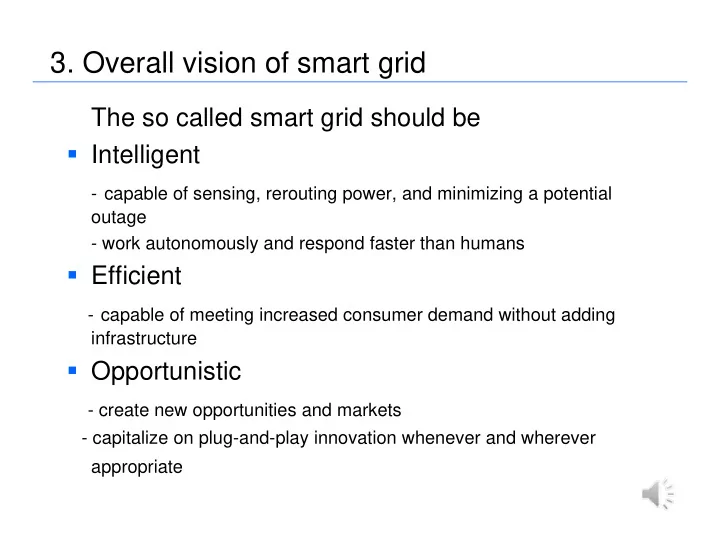

3. Overall vision of smart grid The so called smart grid should be Intelligent - capable of sensing, rerouting power, and minimizing a potential outage - work autonomously and respond faster than humans Efficient - capable of meeting increased consumer demand without adding infrastructure Opportunistic - create new opportunities and markets - capitalize on plug-and-play innovation whenever and wherever appropriate
Vision of smart grid continued Accommodating - accept energy from virtually any source - capable of integrating any better idea and technology easily Motivating - enable real-time communication between consumer and utility - facilitate tailoring of energy consumption based on price and other environmental concerns Quality focused - deliver high quality power without sags, spikes and disturbances - ability to power the increasingly digital economy
Vision of smart grid continued Resilient - increasingly resistant to attack and natural disasters as it becomes more decentralized - reinforced with smart grid security protocols for enhanced security - resilience versus reliability IEEE definition: reliability [engineering] is “a design engineering discipline which applies scientific knowledge to assure that a system will perform its intended function for the required duration within a given environment, including the ability to test and support the system through its total lifecycle.”
Vision of smart grid continued Green - slowing the advance of global climate change and - offering a genuine path toward significant environmental improvement.
4. Scope of smart grid Areas that cover the scope of the smart grid include The delivery infrastructure - e.g., transmission and distribution lines, transformers, switches The end-use systems and related distributed- energy resources - e.g., building and factory loads, distributed generation, storage, electric vehicles Management of the generation and delivery infrastructure at the various levels of system coordination - e.g., transmission and distribution control centers, regional reliability coordination centers, national emergency response centers
Scope of smart grid continued The information networks themselves - e.g., remote measurement and control communications networks - inter- and intra-enterprise communications, public Internet The financial and regulatory environment - that fuels investment and motivates decision makers to procure, implement, and maintain all aspects of the system - e.g., stock and bond markets, government incentives, regulated or non-regulated rate-of-return on investment
5. Benefits of smart grid Increased power efficiency - reduce transmission, distribution and customer load losses - increase efficiency of electrical generation Optimized asset utilization and efficient operation - manage existing plant generation using real-time demand prediction instead of constructing new plants - increase utilization of line capacity
Benefits continued Accommodating all generation and storage options - accommodate various power generation sources - offer net-metering, reduce imported fuel and develop storage technologies Facilitating integration of distributed generation - Provide small-scale on-site generation opportunity as an alternative approach to reduce energy losses in transmitting electricity Facilitating integration of renewable resources - integrate all means of renewable sources - help meet the states’ RPS (renewable portfolio standard) standards
Benefits continued Increased system reliability - predict & respond to system disturbances and reduce outage times - be resilient to attack and natural disasters by self healing Improved outage management - quickly and precisely : identify, locate and respond to fault Improved power quality - reduce losses caused by power quality issues - offer flexible level of power quality based on different customer demand .
Benefits continued More effective consumer load control - Implement effective demand-side management, offer the opportunity of dynamic pricing - allow customers to tailor their energy consumption More effective distribution monitoring - utilize advanced sensing and measurement technology in power distribution system, more effective SCADA system Increased national and information security - protect data and information privacy, and enhance cyber security.
Benefits continued Reduced environmental impact - reduce emissions, CO2, SO2 & NOx, ensure sustainable development Improved national and regional competitiveness - Result in lower electricity rate and energy bills, enable new jobs, services and markets New customer service benefits - Provide the digital channel for two-way communication and better fulfill customer demands New governmental and regulatory benefits - better global intercommunication, more engagement from government and regulatory agency, provide better services
Recommend
More recommend